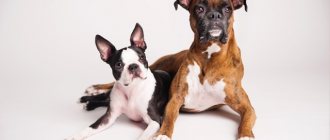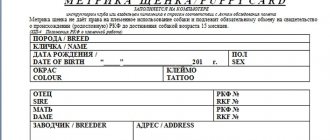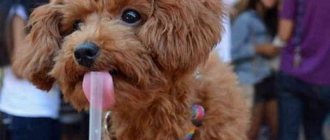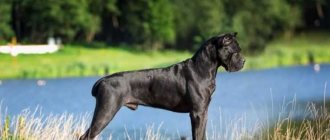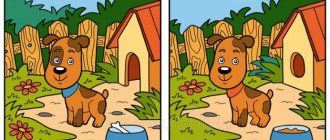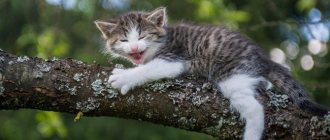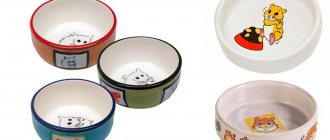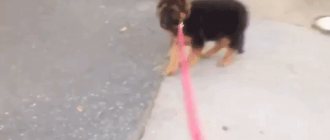All breeds recognized by the Fédération Cynologique Internationale have an official standard. This is a document that lists the requirements for the dog, including its appearance. It happens that adjustments are made to the standard. In this regard, the requirements for a representative of the breed change and, sometimes, quite significantly.
Necessity
The FCI standard for the Cane Corso breed, adopted in 1996, provided for mandatory docking of the ears and tail of these dogs. However, in 2021, a new edition of the breed standard came into force. In accordance with it, the tail and ears should have a natural length and shape, i.e. The dog must be undocked. The RKF uses the standard adopted by the ICF, but provides its own explanations for some points. So, regarding the issue of cupping, the RKF website says the following:
- in countries where docking is prohibited by law, dogs with cropped ears and tails cannot participate in exhibitions;
- Where the law allows docking, dogs with docked ears and tails, as well as representatives of the breed in their natural form, can take part in exhibitions.
The ban on participation in exhibitions of docked Cane Corsos does not apply to representatives of the breed born before 2021.
In Russia, docking is not officially prohibited. However, some breeders refused this procedure due to humane concerns. Partly also in order not to spoil the pet’s exhibition career at international events. At the same time, many continue to believe that Cane Corso with a natural tail length and ear shape look ridiculous. Thus, in countries where the docking procedure is not prohibited by law, the decision remains with the owner.
https://youtu.be/LkmA_p_hQgE
Contraindications to the procedure
The ban on cropping a dog's ears is justified by many factors. The operation is not performed:
- sick pets;
- weakened individuals;
- abnormally developing puppies.
Important! Inappropriate age (adult dog) is also a contraindication. Only a veterinarian can prohibit or allow circumcision.
What breeds is the procedure recommended for?
The intervention is performed on service breed dogs with naturally long ears. Cropped ears can be found:
- at the Great Danes;
- Dobermans;
- schnauzers;
- Rottweilers;
- boxers;
- Cane Corso;
- bull terriers;
- Caucasian and Central Asian shepherd dogs.
Veterinarians' opinion
At what age is it possible and necessary?
The optimal age for a dog to dock its tail is 3-4 days after birth. At this time, the puppies do not feel pain and the procedure will not cause them any discomfort. Even with minimal care, the wound will heal within 5-7 days. Ears are cropped at 1.5-2 months. But it is also acceptable, although not advisable, to carry out the procedure at the age of 3 months. Healing takes about a week.
Changing the timing of ear cropping can negatively affect the formation of the dog’s skeletal system and dentition.
What to feed a Cane Corso puppy?
Price is the first indicator of the quality of an animal! To maintain a Cane Corso in proper conditions, a lot of money is needed. It is also worth paying attention to the following aspects:
- Conditions for keeping pets - the place must be clean and spacious
- The animals themselves must be well-groomed and healthy
- Check puppies and their parents for the absence of dysplasia (this is a weak point of this breed)
- Breeders are required to have documents
- Also study the pedigree of the dogs
- Pay attention to the behavior of the puppies - they should not be intimidated or too aggressive. At a young age, Corsas are active, interested in toys and enjoy playing with other puppies.
- Also, take a closer look at the breeder. A conscientious seller treats each puppy as if it were his own, into which he has invested a lot of effort and his soul in the truest sense of the word. Therefore, a good puppy will never be sold without making sure the buyer’s intentions are correct.
We invite you to familiarize yourself with: Breeding bumblebees for pollination, bumblebee farming
Choose trusted breeders
Important rules:
- It is better to take from a female who gave birth to a litter between 3 and 8 years old. It is by this age that the dog will fully mature and bear healthy puppies.
- We pay attention to the frequency of mating - no more than once a year or even every few years. Then the mother and her puppies will have good health and immunity
- At the age of 1 month, puppies should weigh between 3 and 4.5 kg. The more puppies are born, the less their weight will be (we also pay attention to this)
- In general, you should not take puppies less than 1.5-2.5 months old. During this period, the breeder selects quality pets
- The coat should be shiny, the puppy itself should be nimble, strong and moderately well-fed. But the stomach should not be bloated
- If your eyes are watery, this indicates the possible presence of worms.
- If puppies are over 3 months old, their ears must be cropped.
- The first rule is to chop food into small pieces!
- The second rule is to give enough protein. This is: Lean meat, ideally rabbit or veal. Better boiled. Although veal is sometimes allowed to be given raw, in small pieces
- Also low-fat fish, boiled and without bones
- By-products only in boiled form
- Hard-boiled eggs
Bones are needed to scratch gums
Circumcision procedure
Cupping is a surgical procedure that can only be performed by a qualified veterinarian.
Tail
The tail of Cane Corso puppies is pinched and trimmed with a sharp sterile instrument at the level of the 4th vertebra. It is better to call a specialist to your home to carry out the procedure, who will dock the entire litter at once. Over the next week you need to take care of the wound on the tail , otherwise it may begin to fester.
The ears are cropped using a special template, thanks to which you can quickly give them the shape of an equilateral triangle. The dog cannot be fed 4-5 hours before the operation and 1.5-2 hours after; it must have primary vaccinations. 10 days before the procedure it is necessary to carry out deworming. After cropping, the ears will require careful care, which includes the treatment of sutures, which are removed after 7-10 days. To do this you need to purchase:
- brilliant green;
- cotton swabs and disks;
- tissue-based patch;
- sterile wipes;
- hydrogen peroxide.
In addition, you will need a special collar that will prevent your pet from scratching or chewing on its ears.
At what age should ears and tail be docked?
There are three periods in which the operation can be performed: from birth to two weeks, from two weeks to three months, after three months. The older the puppy, the more expensive the service will cost. In addition, each period has characteristic features of the procedure and recovery after it.
From birth to two weeks
This time is favorable for cupping, since at the first stage of life the tissues are still soft and more easily amenable to surgical intervention . In addition, small puppies do not feel pain as acutely as older puppies, which is also an advantage of early docking.
Another obvious advantage is that during this period the operation will cost the least. In Rostov-on-Don, the cost of cupping the ears will be 500 rubles , in Irkutsk - 1550 , in Moscow 2000 . The highest prices are in St. Petersburg: a service for a puppy under two weeks of age will cost 3,500 rubles. Tail docking costs even less: in Irkutsk - 350 rubles , in Novosibirsk - 200 , in Moscow - 1000 , in St. Petersburg - 1610 rubles .
Such an early procedure also has a significant disadvantage: at this age, the dog’s features are not yet fully formed, so it is difficult to predict what appearance the operated animal will have in the future.
From two weeks to three months
If you are older than two weeks, the surgery will be more painful and the recovery period will be longer. Cupping will need to be done under anesthesia, and then stitches will be applied. As for the result, it now becomes much easier to give the ears a certain shape.
For older puppies, prices are higher: surgery on the ears will cost 1,100 rubles in Chelyabinsk, 2,500 in Rostov-on-Don, 4,000 in Moscow and 5,425 in St. Petersburg, on the tail - 1,500 in Irkutsk, 1,000 in Novosibirsk, 2,200 in St. Petersburg.
After three months
At this stage, the animal’s tissues are already formed and are not as elastic as in the first weeks of life. Cupping after three months is much more traumatic and painful than before. Problems with wound healing and further health consequences cannot be ruled out. In addition, a dog accustomed to its tail will experience psychological discomfort after it is cut off. The operation itself will be a serious test for the pet’s psyche. If possible, you should not delay carrying it out for so long.
To crop a dog's ears at this age will cost about 3,000 rubles in Yekaterinburg, 4,500 in Irkutsk, 6,000 in Moscow 12,200 in St. Petersburg, a tail - 1,500 in Novosibirsk, 2,500 in Irkutsk and 4,500 in St. Petersburg.
How to place after surgery
To give cropped ears a correct and beautiful set (shape), they need to be glued. There are several methods of gluing: “with horns” and “on sticks”.
Horns
For this method of gluing ears you will need:
- adhesive plaster on a natural basis;
- brilliant green;
- cotton wool, cotton swabs and a tampon.
To prepare for the procedure, you need to cut 2 pieces of plaster 10 cm long and 4 pieces 30 cm long and tie a cotton swab with thread, making it more rigid. A shorter piece of the patch is glued in the place where the fold of the auricle passes, on the inside of the ear and secured on the outside. After this, a tampon is inserted into the ear so that the lower edge of the patch is approximately 2 cm above its lower edge.
After this, take a long and wider piece of the patch and stick it on the outside of the ear, from the cut edge up in a spiral. At this time, the “horns” are held, slightly pulled up.
Do not tighten the patch too tightly - this will cause the ear to swell.
Then bridges are installed between the ears. To do this, cut off a wide strip of plaster 40 cm long and, holding the ears parallel to each other, glue them together, wrapping them in plaster.
Basics of the standard
When choosing a dog of any breed, you need to focus on the standard indicators. For the Cane Corso, the breed standard contains clearly defined parameters of the body and each of its parts. It also describes the character of the animals. According to the standard, the ideal Cane Corso must have:
- friendly and flexible character;
- correct proportions of head and body;
- good bite and teeth. It is worth noting that the bite in Cane Corso dogs is formed at a certain age (up to 2–2.5 years). Therefore, this parameter is difficult to determine in puppies;
- optimal weight and height;
- gait, which is distinguished by a wide stride;
- correct body color.
These are the dogs that are used for mating. If the breed standard does not match in some respects, then the animal belongs to the pet class. Such dogs are cheaper and cannot compete for prizes at exhibitions or participate in breeding.
Appearance
Each dog has an appearance that is characteristic of a particular breed. It is important to know what appearance a purebred Cane Corso should have. Let's look at the most important parameters of the standard in more detail.
Head
Representatives of this breed have a rather large head, on which a wide and flat forehead stands out. There is a moderately pronounced dividing groove. However, the head lacks the folds that are characteristic of a mastiff.
The eye sockets and cheekbones are quite pronounced. Dogs have a clear transition from the forehead to the muzzle. The lines of the back of the forehead and nose run parallel. The muzzle itself is square and deep.
Animals have rounded and thick lips that fit close to the teeth and hang down slightly. Complete set of teeth. They are large and grow densely. The bite should form a gap of no more than 0.5 cm. The standard allows for a pincer-shaped bite. However, it can provoke early tooth decay, as well as a weakening of the grip.
Body type
It is also important to know what type of body type a purebred Cane Corso should have. These pets are characterized by a stocky and stable body of an elongated rectangular shape.
The neck is oval, muscular and long. In its cross-section it is equal to the width of the head. There is a pronounced transition from the neck to the withers and a wide back. In this case, the back has a descending line running from the shoulder girdle to the convex lower back, as well as to the inclined croup.
The chest is characterized by an oval classic shape. It is wide and lowered to the line formed by the elbows. Thanks to this body structure, animals are distinguished by elegance and grace.
Forelegs
The forelimbs are set relatively wide, at a slight angle. They are characterized by pronounced muscles. Shoulders are powerful. They are located at a natural angle. The pasterns also have a slight slope. In the area of the toes, the paws resemble those of a cat.
The forelimbs are flexible. Their joints are quite strong. They should not have club feet (turned towards each other) or cross-footed (look in different directions). Both options are considered breed faults.
Hind limbs
The hind legs are not as compact as the front legs. They are characterized by long hips and a prominent rear line. The shins are strong and dry. The hock joints have a slight angle. The hind limbs have sinewy and powerful metatarsals. From behind, the paws should look straight. Any other type is considered a deviation from the standard.
The toes of the hind limbs are longer than those of the forelimbs. Dark curved claws grow on them.
Cupping
Whether the ears and tail need to be cropped is up to each owner to decide for himself. This is an optional requirement. However, docking the ears and tail gives the dog a well-groomed appearance. Thanks to the efforts of animal rights activists, docking the ears and tails of dogs is prohibited in many countries. Therefore, only animals with undocked ears and tails perform at exhibitions.
Previously, ear cropping in the shape of an equilateral triangle was allowed. For these purposes, a special pattern is used. This operation is allowed in Russia. However, to perform it you need to know how to place your ears. Also, such ears require special care at first, otherwise the injured ear will not heal for a long time.
Tail
Many people also used to shorten the Cane Corso's tail. It usually stops at the level of the fourth vertebra. This was done in order to avoid tail fractures in hunting dogs.
Just like a cropped ear, a docked tail requires extra care. It is especially important in the first days after the operation, otherwise the wound may begin to fester.
As you can see, it is no longer necessary to crop the Cane Corso’s ears and tail today. Although in some countries such animals are still found and are even allowed to participate in exhibitions.
Video “Cane Corso after ear cropping”
From this video you will learn about how a dog behaves after ear cupping.
If you are looking for a devoted friend, a reliable assistant, a protector, a hunter, the Cane Corso dog is exactly what you need! This is a very noble breed of dog. One of the ancestors of gladiator dogs, a dog of the Italian breed, simply the pride and heritage of Italy, because this breed was bred here. The Cane Corso is a temperamental and brave dog. And at the same time, she is so sensitive to her owner, capable of constantly being on guard and protecting him. Those who have a pet of this breed in their home can refuse the alarm, because it is a responsible and impeccable guard for the home and family. If a dog feels threatened, it will be very aggressive against intruders.
Features of the Italian guard Cane Corso breed
An example of an undocked dog of the Central Asian Shepherd breed. An example of a docked dog of the Central Asian Shepherd breed.
Doberman
An example of an undocked Doberman dog. An example of a docked Doberman dog.
Pit bull terrier
An example of an undocked pit bull terrier dog. An example of a docked pit bull terrier dog.
Giant Schnauzer
An example of an undocked Giant Schnauzer dog. An example of a docked Giant Schnauzer dog.
miniature pinscher
An example of an undocked miniature pinscher dog. An example of a docked miniature pinscher dog.
Cane Corso
An example of an undocked Cane Corso dog. An example of a docked Cane Corso dog.
This representative belongs to the category of ancient Molossians, which comes from Italy. And the story itself is already fascinating and frightening at the same time - these are the descendants of gladiator dogs from Ancient Rome. But you shouldn’t completely identify Corsos with them.
- Since ancient times, they were bred to protect man and his territory. Translated from Latin, Cane Corso means “guard dog” (“canis” - dog, “cohors” - guard). Therefore, the main character traits of such a dog are the absence of fear and incredible devotion to the owner!
- And the main priority is the protection of the owner, his family members and all property. To understand the loyalty of the Cane Corso, we suggest making a comparison with other breeds. Their loyalty is higher than that of the German Shepherd, but lower than that of the Shih Tzu. Approximately on par with a Doberman or Great Dane.
- They have an instinct in their blood to protect the smaller and weaker themselves, so Corsas will not attack a child and will always protect your child. Although this aspect requires more attention, which we will consider a little later.
- They love to play and even as they age they remain active. They have well-developed muscles, so this breed can be classified as an athlete.
- But at the same time they are unobtrusive. They won't bother you with their games or demand your attention.
- This is a very strong breed that is on the same level as the Rottweiler, but is slightly inferior to the St. Bernard.
Thoroughbred
Beautiful and elegant
As a rule, dogs of this breed are strong, powerful, beautiful, robust, and elegant at the same time. The muscles are very pronounced, thereby giving the dogs a rather menacing and intimidating appearance. Has a wide chest and powerful shoulders. The coat is a beautiful and shiny black color; there are also brown and brindle colors, very piquant and unusual, which may also be of interest. White spots on the chest, paws, and nose are rarely allowed.
Such dogs are simply unique in character, they seem to consist of nothing but virtues, they are balanced, predictable, and are never aggressive without a reason. The main advantages include the excellent protective qualities of the breed. All members of the Cane Corso family will feel safe. The dog loves to play active games. Thus, it can become your good friend and partner. They can easily take care of children and other animals; it is in the blood of a dog of this breed. They are kind, affectionate, attentive, but they demand the same in return.
Is Cane Corso dangerous, have there been attacks on people?
Although the Cane Corso grows to an impressive size and has a very intimidating appearance, it is one of the calmest and most balanced breeds. They are very smart and differentiate between a game and a real threat. Therefore, they never attack just like that, without an order or obvious reason.
But still, rare cases of Cane Corso attacking a person have been recorded!
- The most notorious case is that in Moscow, three-year-old Ginger attacked his owner and bit him to death. The family and the dog handlers themselves are surprised by the dog’s behavior. Experts put forward versions that the reason for everything is mental disorders in the dog, which existed even before the acquisition.
We suggest you familiarize yourself with: Rating of food for medium breed puppies
You can also find isolated cases where Cane Corso attacked strangers.
- For example, in Nemchinovka, owners neglect to walk two muzzled dogs. Therefore, they repeatedly attacked other dogs and even people. There have been no deaths so far, but serious injuries have been reported.
- And one more case - in Pskov. Two Cane Corsos attacked a woman and seriously injured her. Although this is not the first time they have attacked strangers. In this situation, the fault is also entirely on the owners - they led an inadequate lifestyle and did not engage in any activities, and sometimes even offended the animals.
For protection only
Simple and obedient
Caring for and raising a pet of this particular breed is simple. Sufficiently monitors the hygiene and cleanliness of the wool. It is better to keep such dogs for those who live in a private house or country house, they love to run, they need freedom. Such a dog is not kept on a leash, and in winter the pet does not need to spend the winter outside, it has thin fur. It's easy to train a dog, it's smart and obedient!
If you have purchased a Cane Corso puppy, you should take this seriously. It is necessary to determine for him a place where he will feel comfortable and warm, safe. Monitor his diet and health, get all the necessary vaccinations and procedures, and also think about the question of how to install the ears and cropping the puppy’s ears. The ears of a dog of this breed may not be cropped. They are hanging, wide at the base, and set high. However, more often they are stopped, usually in a triangular shape. This gives the dog a more well-groomed and menacing appearance, due to the structure of its muzzle and skull.
By the way, many owners of dogs of this breed simply do not imagine their ears drooping, this is from the experience and practice of experienced dog breeders, and even more so this applies to the dog’s tail. In all of nature there are almost no dogs with drooping ears; remember their ancestors - wolves. This is not a whim at all, but simply a vital necessity for your pet. Nowadays, such operations are simple, but very important, because ears are cut once and for the rest of the dog’s life!
Keeping Cane Corso in an apartment
It is possible to keep a Cane Corso in a spacious apartment. But there are a number of requirements:
- We exclude slippery floors such as laminate, parquet or tiles
- Until the age of six months, it is better to use carpet or carpeting
- We place a bowl of food or water in the kitchen or hallway. But so that no one disturbs the pet during the meal
- Corsas should have their place! This should be just their corner where they can hide from uninvited guests. If it is not possible to allocate a whole small room (maybe part of a room), then use a cage or fence. Cane should have his own territory with toys.
- There should be enough toys so that the animal can entice itself while staying in a house without its owners. Otherwise, furniture will be used. The need to scratch your gums especially increases when you change teeth.
We invite you to familiarize yourself with: What forms of animal behavior exist?
By the way, you might be interested in the article on the topic “When do dogs’ teeth change?”
Energy output
Under no circumstances should the Cane Corso be kept on a chain! This is a very freedom-loving breed. On the street, just in a booth - this is not a suitable option for such a noble dog. Moreover, we do not forget that the pet does not have the necessary undercoat for the cold period.
- If you decide to get such a dog and want to keep it outside, then you should take care of a warm enclosure. Its area must be at least 10 m².
- Under no circumstances should the floor be made of concrete - it is very cold. Ideally, choose wood; asphalt will do.
- It is forbidden to make an enclosure out of mesh. The dog will chew the wire, injuring its teeth. Therefore, we give preference to thin pipes or thick metal rods.
- Under no circumstances should the door open outwards!
- Be sure to make a roof so that the animal can hide from rain or sun. Consider protection from drafts.
- It is worth placing a small insulated booth on the territory. It is the small dimensions of the house according to the size of the dog that will help better retain heat inside. You can insulate with polystyrene foam, foam or sawdust. But the entrance to the booth should be spacious so that the dog does not bend over.
- The optimal temperature is within 10-15 °C. Under no circumstances allow temperatures to reach zero or minus temperatures! Therefore, consider a heating system for the winter. If they claim that an animal can withstand even sub-zero weather down to -20 °C, then this is clearly a cors of dubious pedigree.
There must be plenty of space
Put it right
It is important that the specialist places the ears correctly and that they fit the pet. You should also know that after surgery you will have to take care of your dog's ears for some time. In order for such ears to stand beautifully, the owner must take care and glue the cartilages with adhesive tape so that they stand beautifully. After all, this breed's ears are trimmed in a triangle.
Choose an experienced and trusted veterinarian so that he knows how to position the Cane Corso's ears correctly.
Remember that the puppy must be absolutely healthy before docking its ears and tail! He should not have fleas or worms. Vaccinations can be done during this period. For about twelve hours before surgery, do not let your puppy eat and keep an eye on him. Let the puppy be calm before anesthesia; do not play with him. Prepare in advance the medications you may need: brilliant green, antiseptics, bactericidal powders, hydrogen peroxide, sterile wipes, paper-based adhesive plaster only, a postoperative collar and whatever the veterinarian tells you to look after cropped ears.
